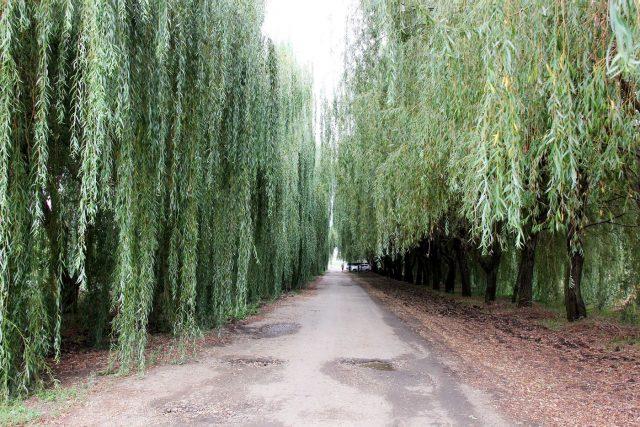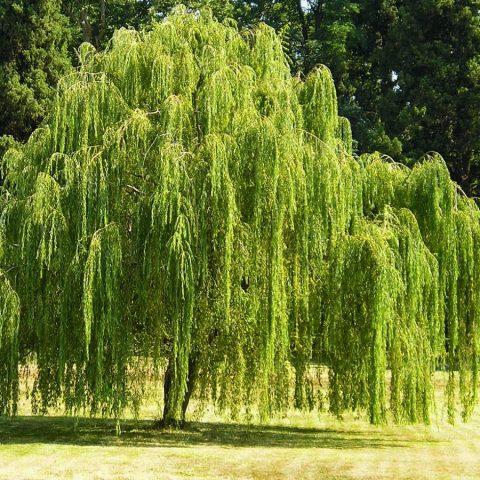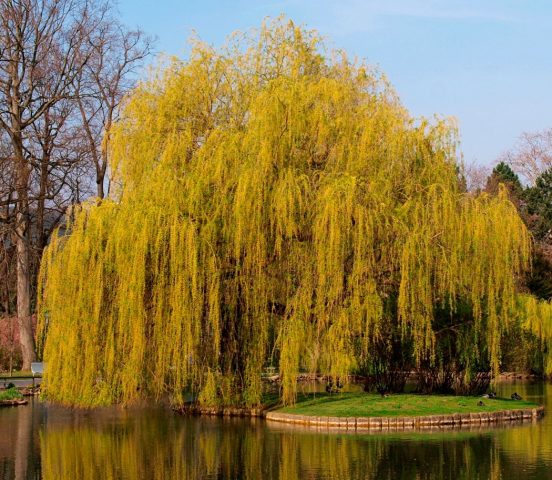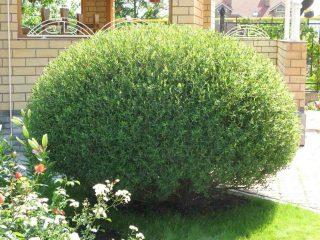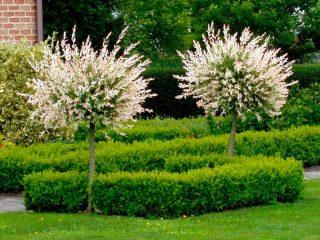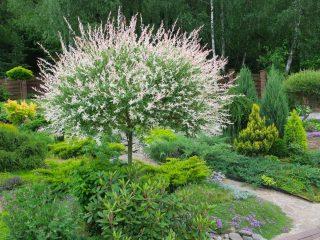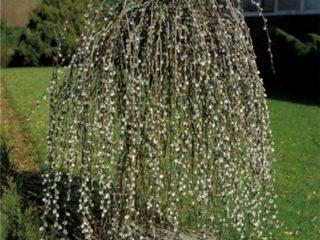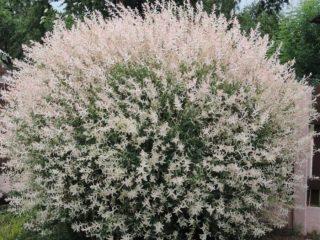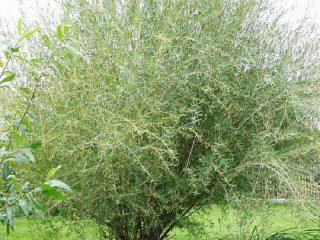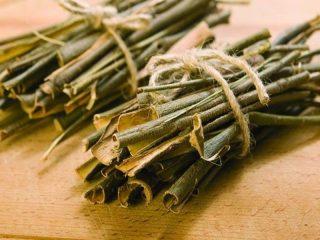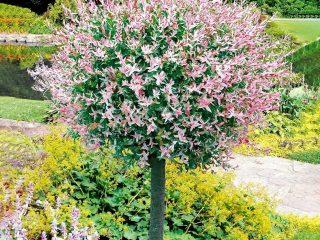Content
Babylonian willow is a relatively large tree, reaching a height of 2 to 12 m depending on the variety. It produces a spreading crown with drooping branches. This willow looks good in single plantings, especially on the coast of a reservoir, as well as in compositions.
Description and photo of Babylonian willow
The Babylonian willow variety is represented by a rather large tree, which reaches a height of 10-12 m. The width of the trunk when cut is about 50-60 cm. The crown of the tree produces long, thin branches that hang to the ground. They are naked, without pubescence, glistening in the sun. The color is reddish or yellowish-green.
Willow has oblong, narrow, lanceolate leaves. They end with a point, extend towards the top, and gradually narrow towards the base. In size, the leaf plates of the Babylonian willow tree are quite large - 10-16 cm long, and small up to 2.5 cm wide. The edges are serrated, the color of the outer part is dark green, and the lower part has a bluish tint.
Young foliage is slightly pubescent, while mature foliage has no covering at all. There are quite a lot of veins, up to 30 pieces, they extend at different angles from 45 to 70 degrees.The stipules are oblique, lanceolate in shape, sometimes subulate and toothed. The petioles are small, up to 1 cm long, hairy, often glandular.
Babylonian willow produces flowers - thin catkins, they can appear both before and after foliage. They are located on small branches. Each flower has two free stamens. The calyxes are ovoid, narrow, yellowish-green in color, sometimes pale fawn, monochromatic. The stigmas of the pistils are thickened, yellowish, and contain from two to four wide lobes.
Babylonian willow is quite winter-hardy, but can freeze in cold winters. The root system is powerful and develops until it finds a source of groundwater. Structures the soil well.
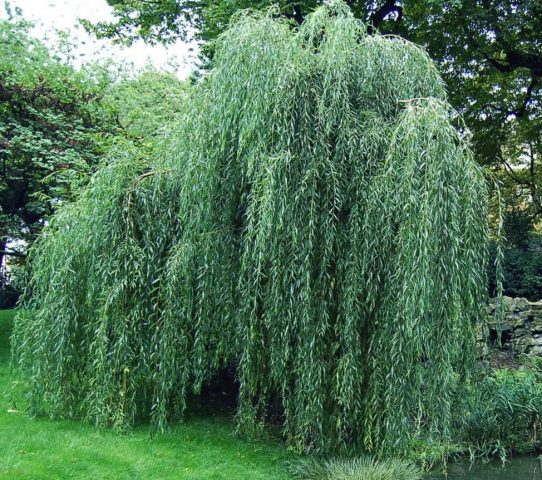
Willow produces a spreading crown and weeping shoots
Varieties of Babylonian willow
Two varieties have been developed - Crispa and Tortuosa. They can be grown in the climatic conditions of most Russian regions. Each is described in the following sections.
Crispa
The Babylonian willow variety Crispa is a shrub or small tree with a cone-shaped crown. It grows only up to 1.5-2 m. At the same time, the annual growth is quite large, from 30 to 50 cm. The foliage is steeply spiral, large, and of unusual shape. It reaches a length of 10 cm, the shape of the leaf blade is lanceolate.
The color of the outer part is dark green, with bluish tints below. The leaves of the Babylonian willow tree curl into a spiral, making them resemble miniature roses. Catkins with short petioles, thin, appear after the foliage blooms.
Babylonian willow Crispa is a fairly winter-hardy variety; at the same time, it can suffer from severe frosts, but then quickly recovers.When caring, you should take this feature into account and cover it with burlap for the winter, at least in the first two years after planting. The top is carefully sprinkled with snow. The soil is hilled up in advance, forming a mound 20 cm high.
The Babylonian willow variety Crispa is used in single plantings, as it decorates the garden with original leaves. In addition, the tree is small, looks elegant, and does not take up much space. Most often, seedlings are placed in open clearings with maximum lighting.
Tortuosa
There is another famous variety of Babylonian willow - Tortuosa. It is represented by a small deciduous tree, less often a shrub with an elegant, openwork crown. This effect is created by long thin shoots; they twist in a spiral, reminiscent of a corkscrew. The color is olive or slightly yellowish, gradually acquiring a gray-brown tint.
Compared to Crispa, the tree is noticeably taller - reaches 4-7 m, and in width - 5-6 m. The growth is also quite large - 25 cm per year. The crown is weeping and looks quite attractive due to its volume.
The trunk of this variety of Babylonian willow is slightly twisted, the bark is rough, brown, and slightly cracked. The leaves are lanceolate, light green on the outside and bluish on the back. By autumn, the leaf blades turn yellow and fall off.
Willow is distinguished by early flowering - from late March to mid-April. Around the same time, leaves appear. The earrings are inconspicuous, small, grayish in color.

Medium-sized willow with a very lush crown
This type of wood is undemanding to care. Grows well in fresh, fertile and moist soils. If the soil is depleted, you can apply fertilizer, and the shrub will develop quite well.
Planting Babylonian willow
You can plant a Babylonian willow seedling both in the first half of April and in September, 30-40 days before the onset of the first frost. The planting site is chosen to be completely open, without shade, but at the same time protected from the winds. The soil can be almost any, including infertile. First, complex mineral fertilizer or organic matter (humus, compost - a bucket per square meter) is added to it.
When planting willows, proceed as follows:
- Dig several holes 60x60 cm at a distance of 5-6 m.
- Fill in a layer of drainage stones.
- Root a willow seedling and sprinkle it with soil.
- Compact, leaving the root collar on the surface.
- Water and mulch.
Babylonian willow care
To grow a beautiful Babylonian twisting willow, as in the photo and in the description, you must follow several rules:
- Water regularly, especially young seedlings. Water should be given every week or twice a month. It all depends on the weather and soil conditions. The soil should not be too wet, but it should not be allowed to dry out either.
- They feed the willow every spring - it is necessary to give ammonium nitrate or urea in the amount of 20 g per 1 m2 for fast growth.
- The soil in the tree trunk circle needs to be loosened monthly, especially after heavy rains. If necessary, do weeding.
- Every spring and fall, the willow tree needs to be pruned to obtain and maintain the desired crown shape, as well as remove old branches.
- For the winter, young willow seedlings are covered with burlap, and the tree trunk circle is mulched with sawdust and straw.
Reproduction
Babylonian willow can be propagated by petioles. At the end of May or at the beginning of June, several shoots of last year's growth are cut, cuttings 15-20 cm long are obtained. Next, an oblique lower and straight upper cut is made, placed in a jar with water and a solution of a growth stimulant, for example, "Epin".

The cuttings are placed in water until roots form.
After the roots appear, they are planted in the ground, covered with a jar, periodically watered and ventilated. For the winter, cover with a large layer of mulch. Next fall, you can transplant the Babylonian willow cutting to a permanent place and carefully mulch it again.
Diseases and pests
Babylonian willow does not have strong immunity - the tree can suffer from black spot, powdery mildew, rot, and willow scab. Therefore, in the spring it is necessary to carry out preventive treatments with fungicides:
- "Tattu";
- "Ordan";
- "Profit";
- "Fundazol".
Willow can also suffer from aphids, spider mites, leaf beetles, and willow weed. Insecticides are used to kill insects:
- "Agravertine";
- "Biotlin";
- "Vertimek";
- "Fitoverm" and others.
Babylonian willow in landscape design
Willow is often used in single plantings. Small trees can be used to create a green hedge - then they should be planted at intervals of 1.5 m. Willows are also used to create green labyrinths, in alleys, next to gazebos and arches. They are used both for single plantings and for compositions, for example, in alpine slides and rockeries.
Below are several options for using willow in landscape design:
- Alley.
- Single landing.
- Willow next to a hedge.
- On the shore of the pond.
Conclusion
Babylonian willow is undemanding to care and grows even on infertile soils.The tree freezes in cold winters, but recovers fairly quickly. Therefore, it can be grown in almost all Russian regions.
